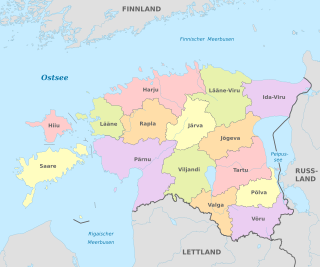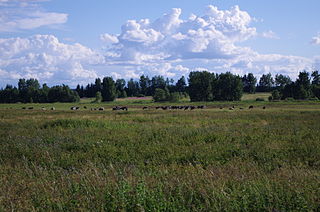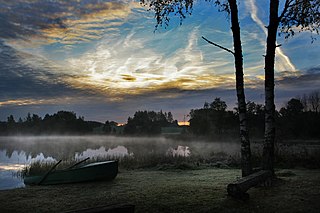
Saaremaa is the largest and most populous island in Estonia. Measuring 2,673 km2 (1,032 sq mi), its population is 31,435. The main island of the West Estonian archipelago, it is located in the Baltic Sea, south of Hiiumaa island and northwest of the Gulf of Riga. The administrative centre of the island, and of the Saare maakond (county), is the town of Kuressaare.

The counties of Estonia are the state administrative subdivisions of Estonia. Estonian territory is composed of 15 counties, including 13 on the mainland and 2 on islands. County governments were abolished at the end of 2017, with their duties split between state authorities and local governments, and nowadays counties have no noteworthy independent competences. Counties are composed of municipalities of two types: urban municipalities or towns, and rural municipalities or parishes, which are by law required to cooperate in development of their county.

Pärnu County is one of 15 counties of Estonia. It is situated in the south-western part of the country, on the coast of Gulf of Riga, and borders Lääne and Rapla counties to the north, Järva and Viljandi counties to the east, and Latvia to the south. In 2022, Pärnu County had a population of 85,705 – constituting 6.4% of the total population of Estonia.

Rapla County is one of the fifteen counties of Estonia. It is situated in the north-western part of the country and borders Järva County to the east, Pärnu County to the south, Lääne County to the west, and Harju County to the north. In 2022 Rapla County had a population of 33,529 – constituting 2.5% of the total population of Estonia.
ISO 3166-2:EE is the entry for Estonia in ISO 3166-2, part of the ISO 3166 standard published by the International Organization for Standardization (ISO), which defines codes for the names of the principal subdivisions of all countries coded in ISO 3166-1.

Tartu County is one of 15 counties of Estonia.

Võru County is a county in southern Estonia. It is bordered by Valga and Põlva counties, Latvia's Alūksne and Ape municipalities, and Russia's Pskov Oblast.

Wilhelmine Schröder-Devrient, was a German operatic soprano. As a singer, she combined a rare quality of tone with dramatic intensity of expression, which was as remarkable on the concert platform as in opera.

Võros are the indigenous inhabitants of historical Võromaa, a region in Southeastern Estonia. The term is particularly used by proponents of a regional identity.

Setos are an indigenous Finnic peoples and linguistic minority that have historically lived in the borderlands between modern day Estonia and Russia. Setos have historically spoken the Seto language and been Orthodox Christians. The Seto language belongs to the Finnic group of the Uralic language family. Since the early 2000s, the Setos have sought greater recognition, rather than having their language considered a dialect of Estonian. Eastern Orthodox Christianity, with influences from local folk religions is widely practiced by the Seto peoples.

Jõeranna is a village in Hiiumaa Parish, Hiiu County in northwestern Estonia.
Mehama is a village in Saaremaa Parish, Saare County in western Estonia.

Siim Kabrits is an Estonian entrepreneur and former politician. He was a member of Riigikogu from April 6, 2011, to March 26, 2014.

Õisu is a small borough in Mulgi Parish, Viljandi County, in southern Estonia.

Mõnnaste is a village in Viljandi Parish, Viljandi County, Estonia. Until the 2017 administrative reform of Estonian municipalities the village was located in Tarvastu Parish. Mõnnaste is 15 km southeast of the town of Viljandi near the western shore of the lake Võrtsjärv. The population of Mõnnaste was 69 people as of 2011.

Mari Raamot was an Estonian socialist, homemaker, and founder of the Estonian women's national defense movement.

Mulgi Parish is a rural municipality in southern Estonia. It is a part of Viljandi County. As of 2021, the municipality has a population of 7,372, and covers 881 km2 (340 sq mi).
Uno Lõhmus was an Estonian judge, Chief Justice of the Supreme Court of Estonia from 1998 to 2004.
Karksi Airfield is an airfield in Karksi-Nuia, Viljandi County, Estonia.
















